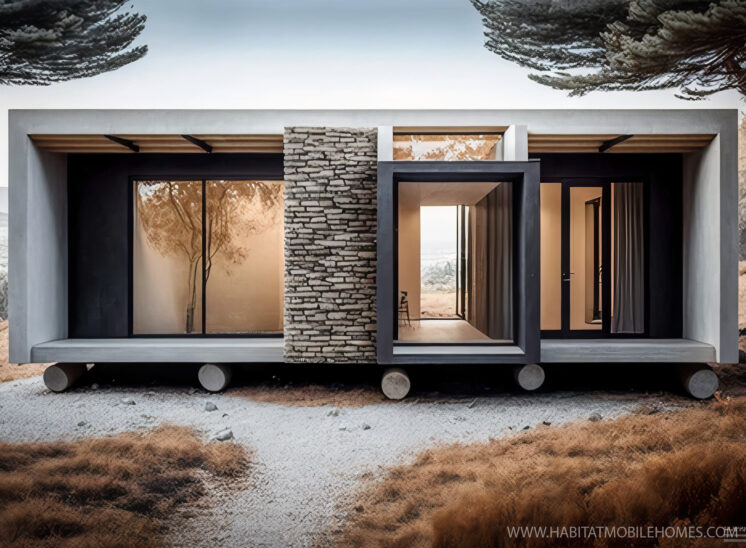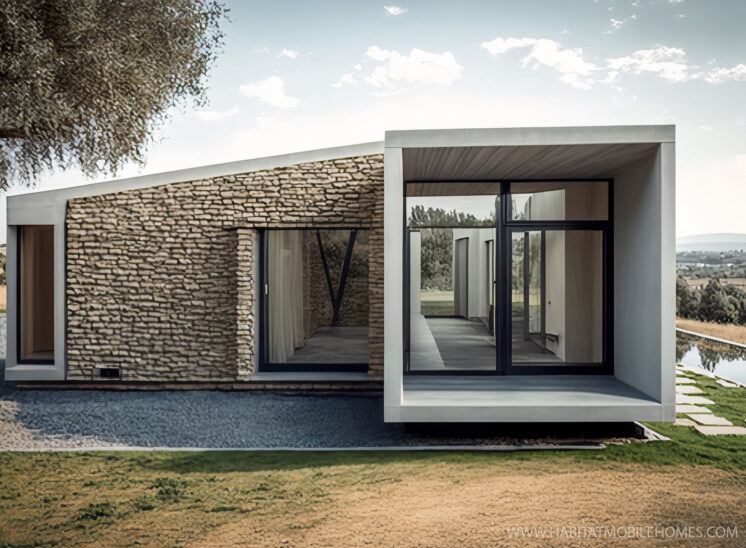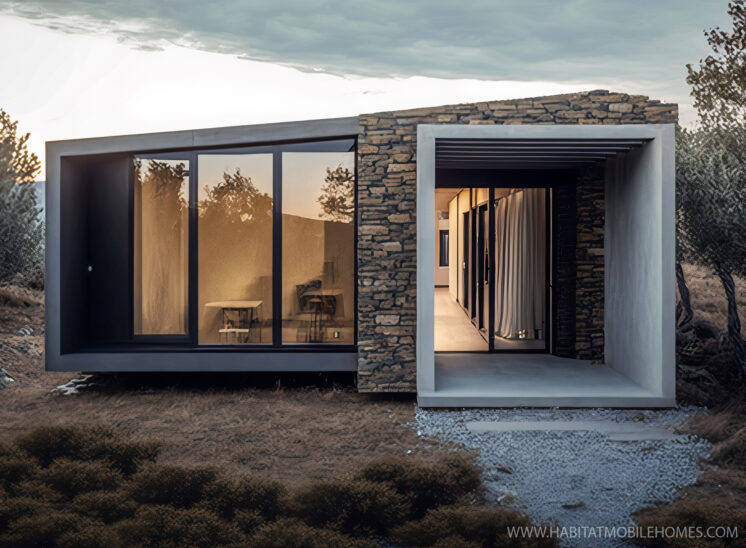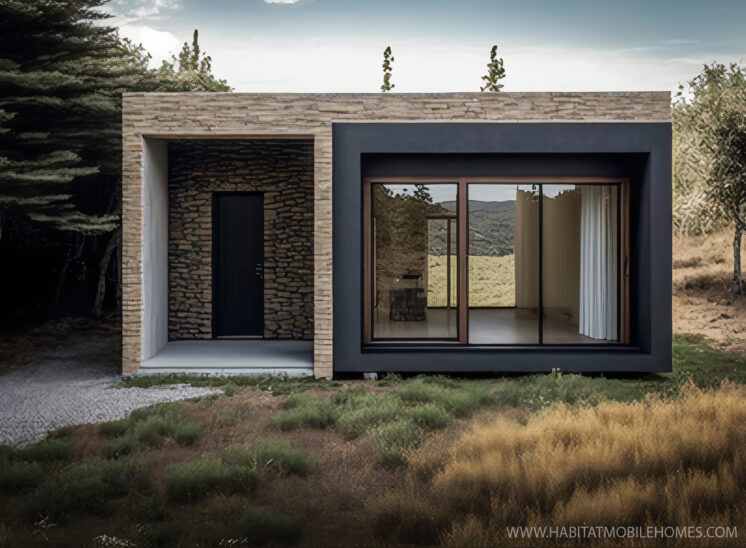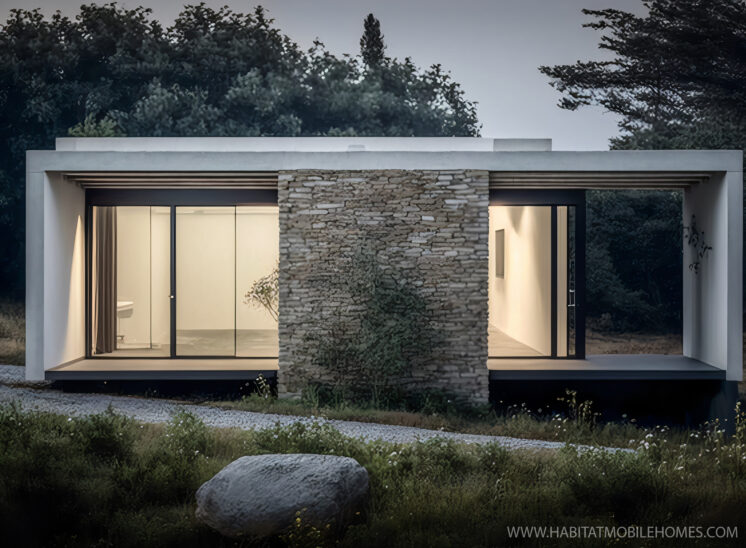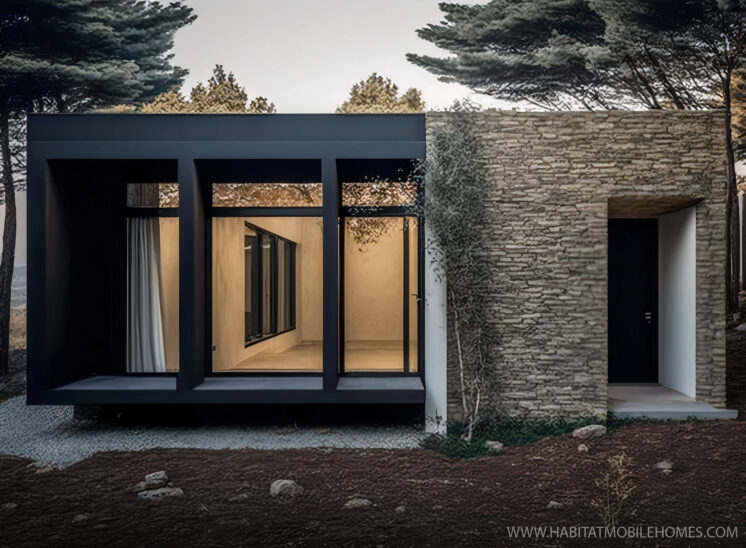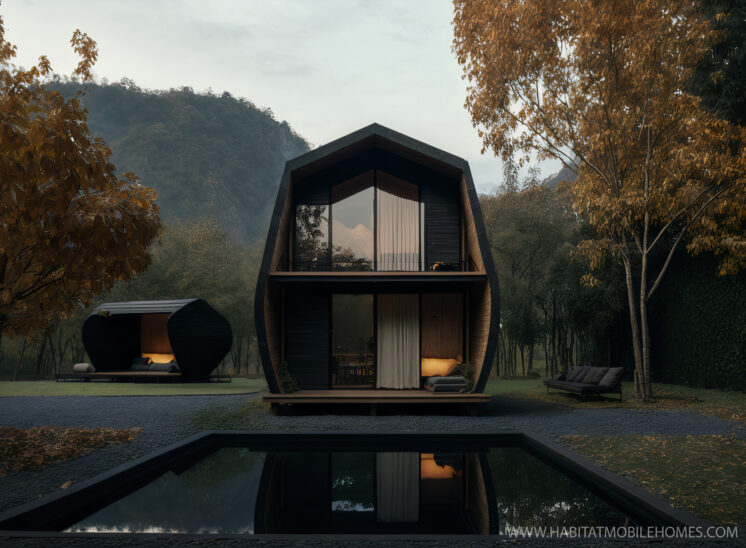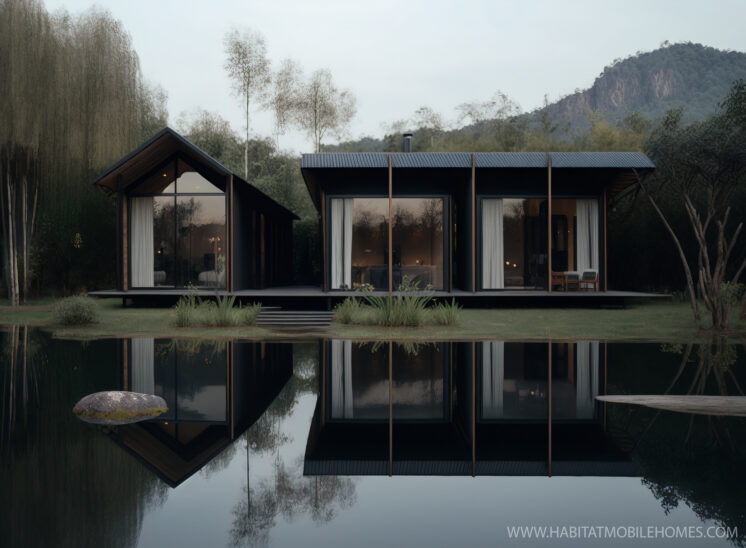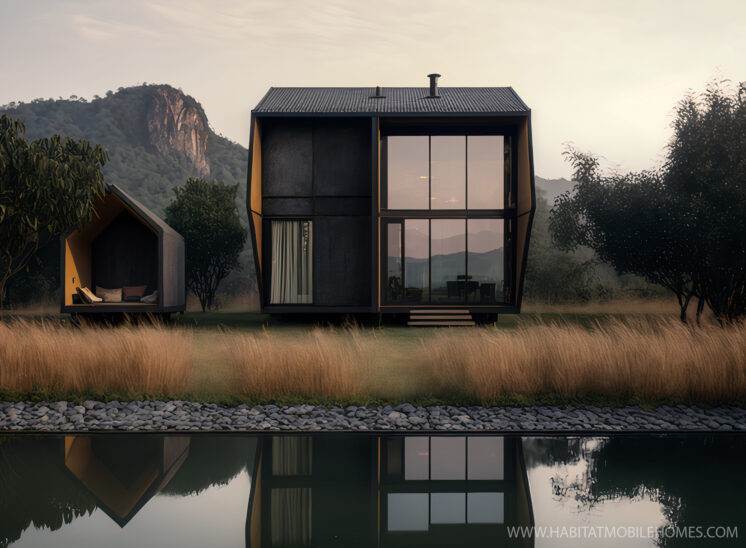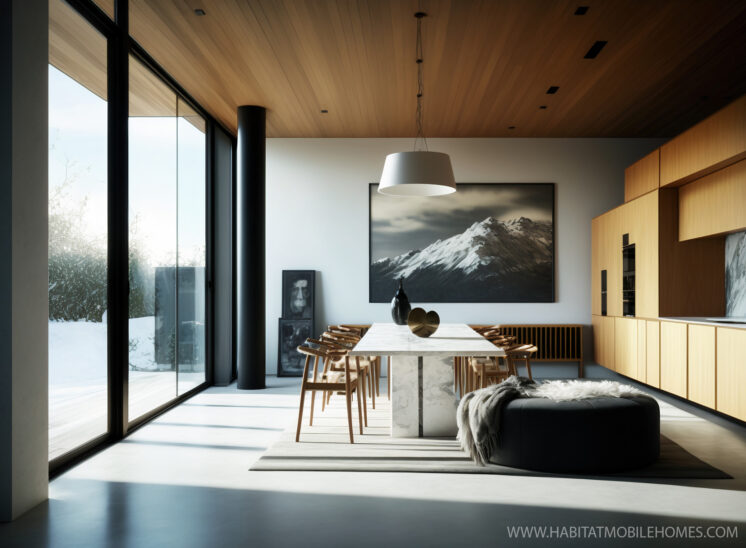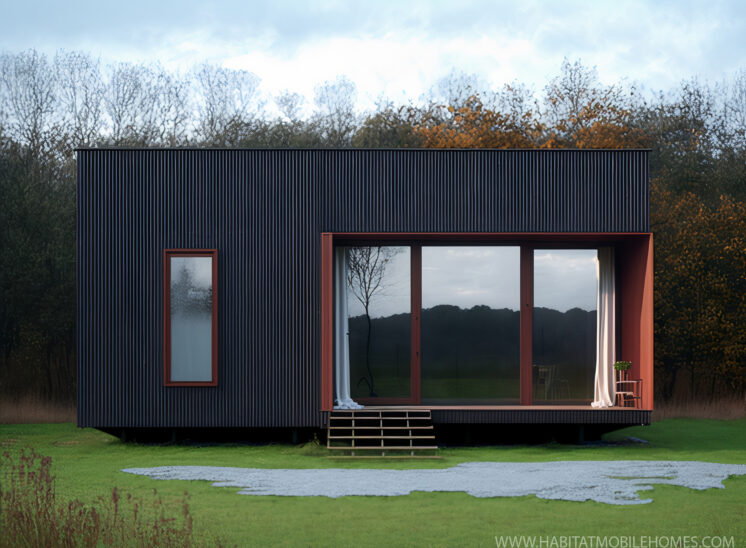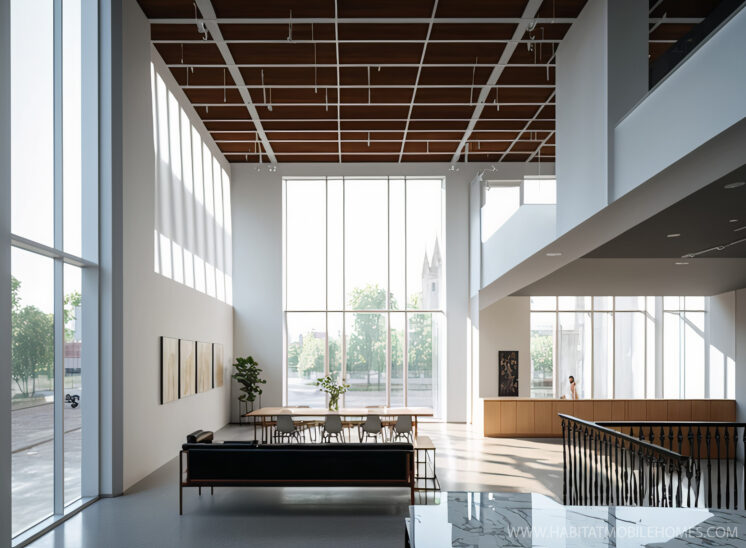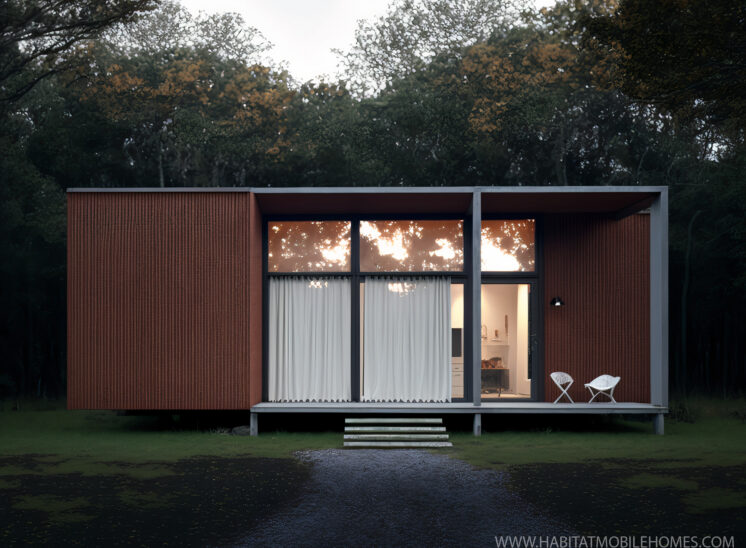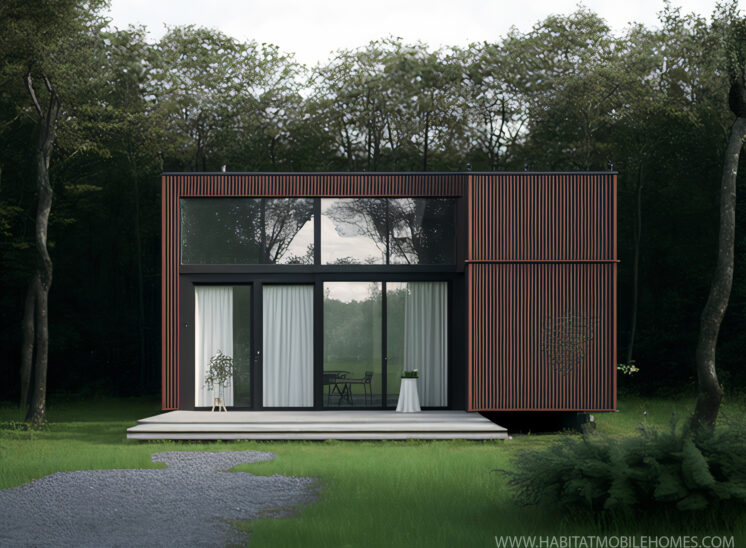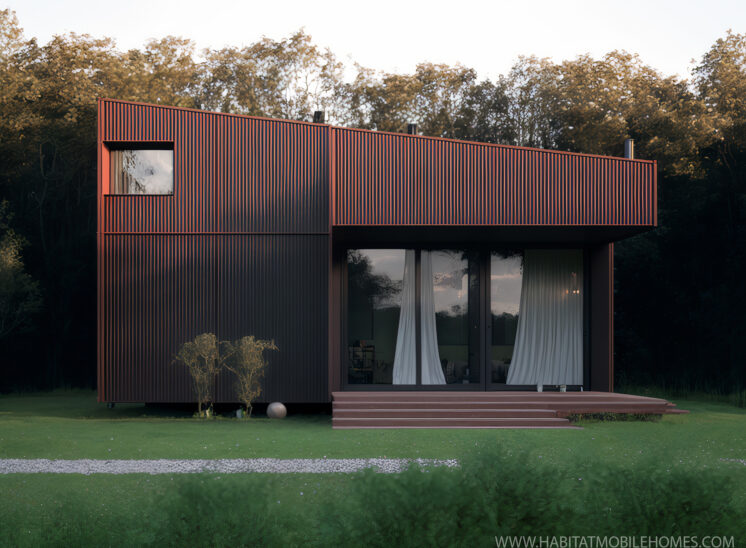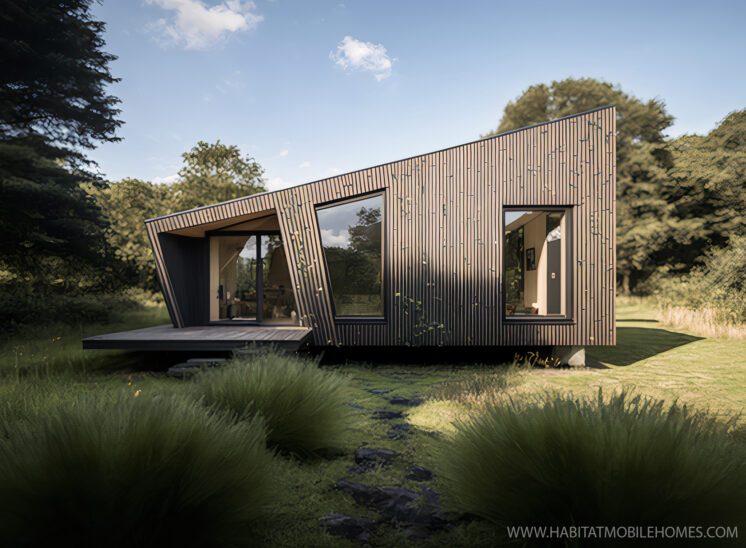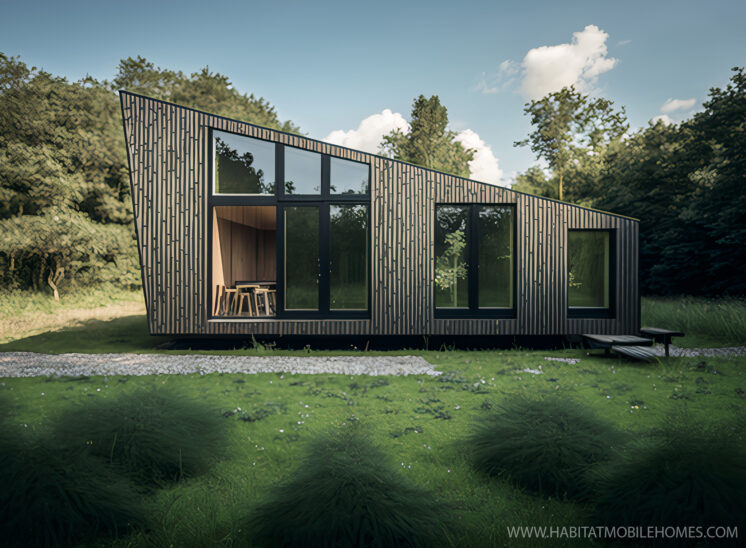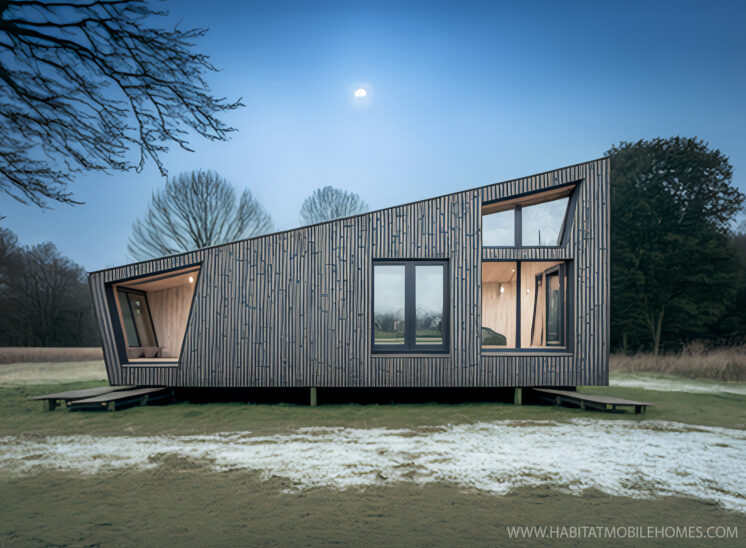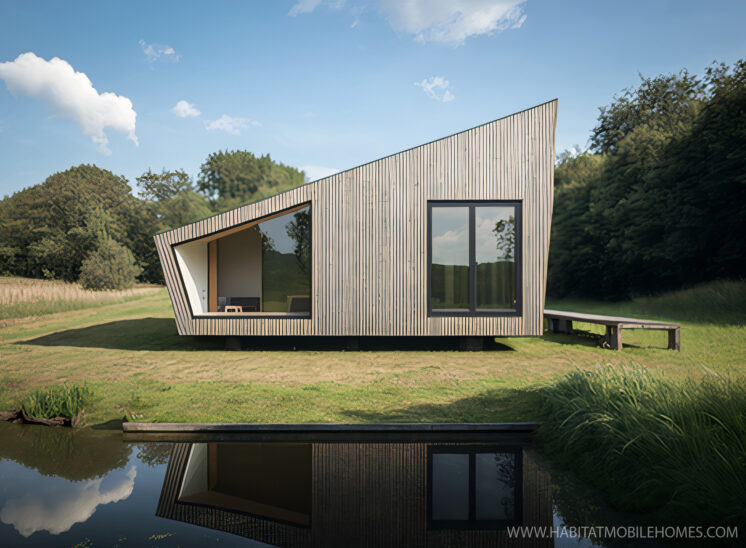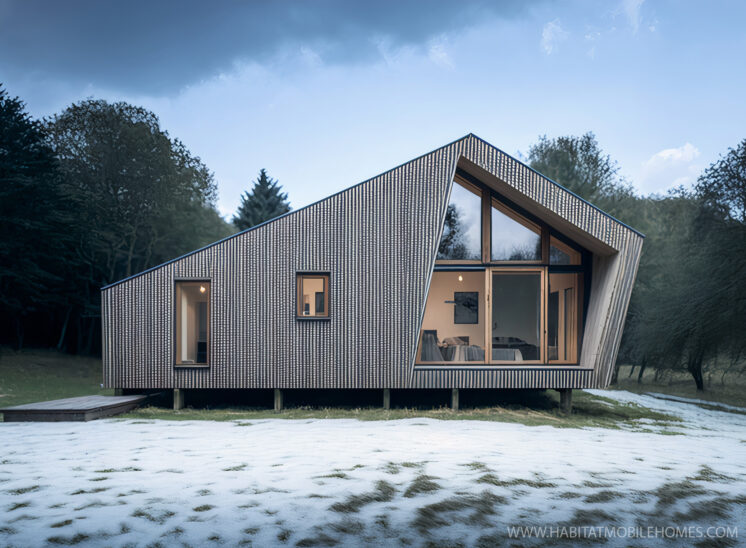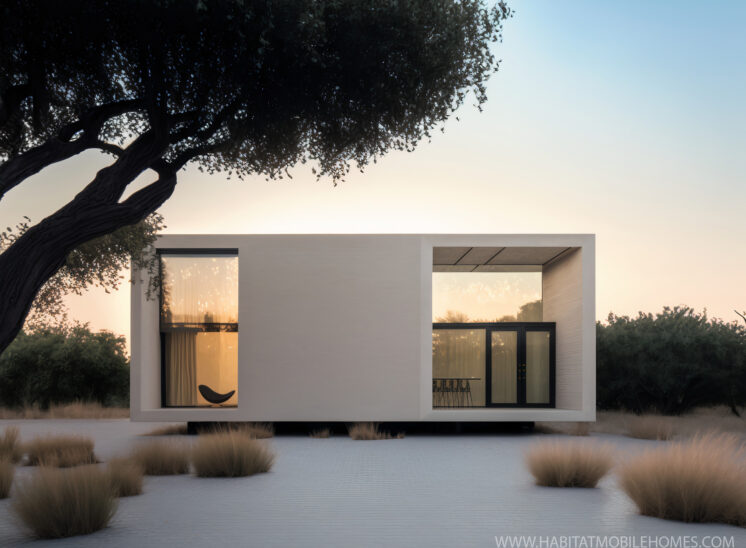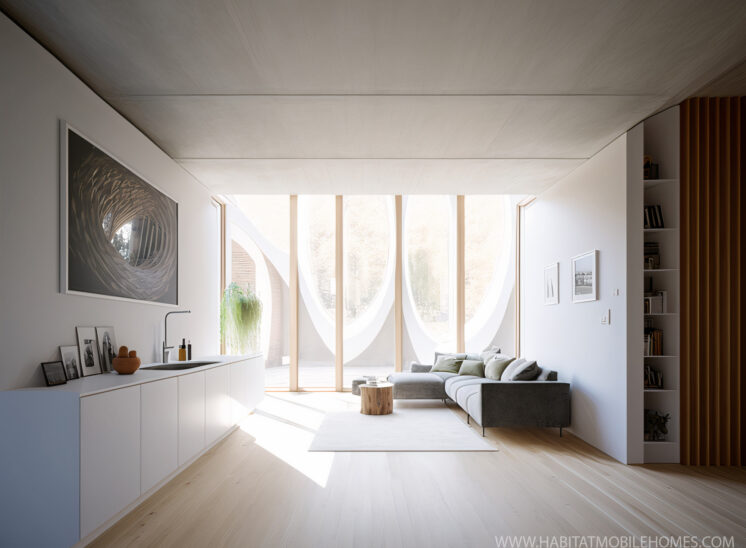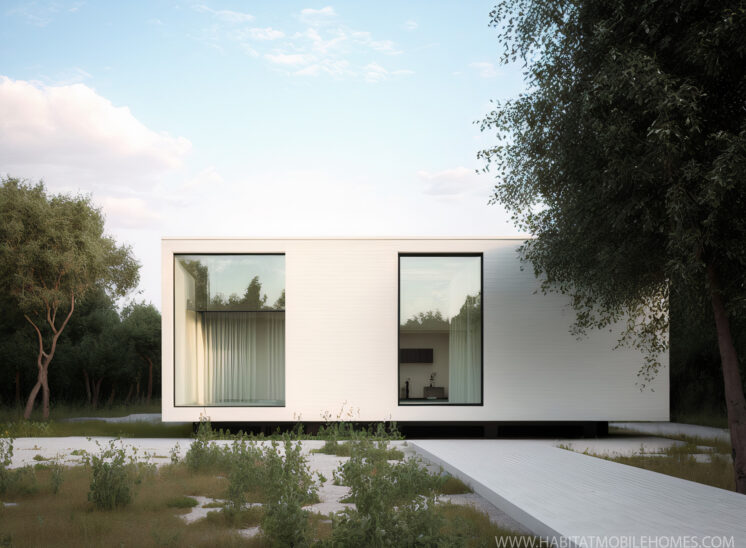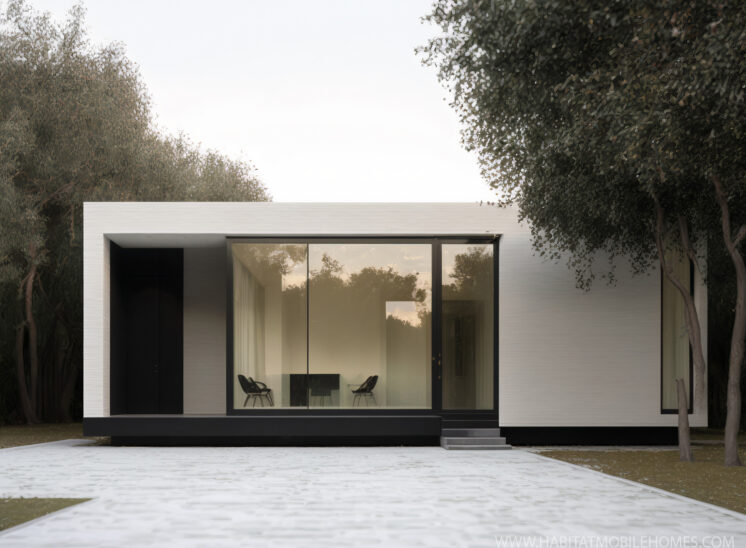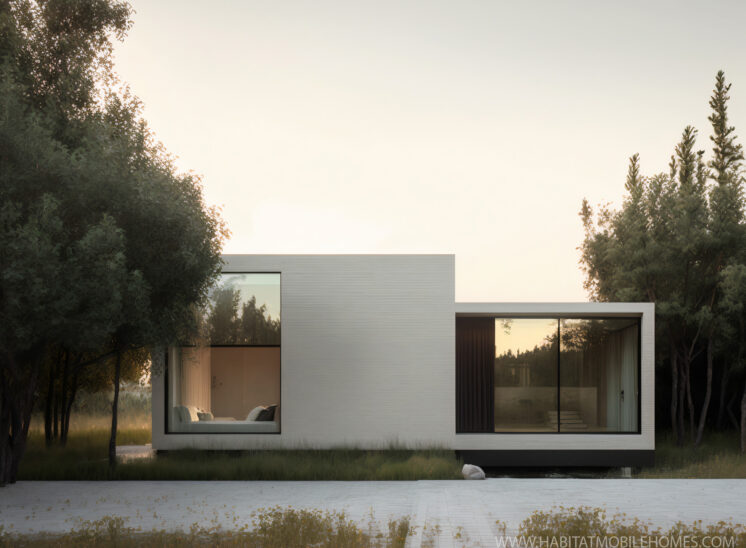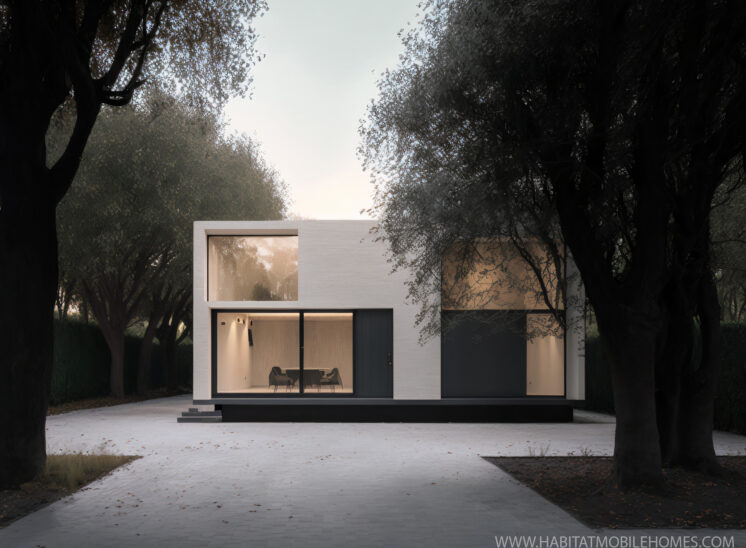Mobile Homes in Gardens Planning Guide
A mobile home will not require planning permission based on the follow criteria:
Location
The caravan must be in the ‘curtilage’ of a dwelling house. This is the drive or garden, not adjoining paddock land, for example.
In James v Secretary of State for the Environment 1990 it was held that there are three criteria for determining whether land is within the curtilage of a building, namely:
1.physical layout
2.ownership, past and present
3.use or function, past and present
Definition of a ‘Caravan’
The actual structure must conform to the legal definition of a ‘caravan’ described in the Caravans Sites and Control of Development Acts 1960 and Associated Articles.
Appeal Decision by the Secretary of State (Erewash Borough Council 2002) determined that there are 3 tests to be applied to the park home:
1.construction test
2.mobility test
3.size test
Use
The use must be incidental to the use of the house, meaning used in conjunction with. There are 4 accepted ‘incidental’ tests, reported to the House of Commons (Hansard, for 22 November 2005) as arising from relevant case law. These are:
1.the relationship between the respective occupants
2.the relative size of the house, its garden and the caravan
3.the relative scale of accommodation in the caravan and the house
4.the degree to which the caravan is functionally connected to and subordinate to the use of the dwelling house
Overview of the Law – Caravans in Gardens
A caravan, be it a touring or static caravan or a large twin-size mobile home, is regarded as an article of movable personal property known as a ‘chattel’ and there is no public law preventing one being kept in someone’s garden, but there are Laws that regulate the ‘Use’ of land.
The siting of a caravan within the garden of a property does not require express consent provided a ‘material change of use’ has not occurred. Gardens are used for the enjoyment of the main dwelling house. If a caravan is parked in a drive or sited in a garden and used by members of the household in connection to the enjoyment of the house or as extra accommodation for visiting guests, provided the occupants continue to use the facilities of the house, then the siting of the caravan has not changed the ‘use’ of the land. However, if for example a caravan is sited in a garden and used as business premises, separately rented or used as a primary independent dwelling, with no relation to the main house, the local planning Authority could decide that an unauthorized ‘material change of use’ has occurred, for which planning permission will be required.
Mobile Homes and Caravans can be sited and used in a garden without the need for express planning consent. If the use is not considered part of, or incidental to, the house, then a ‘material change of use’ may have occurred. If the caravan is not considered to conform to the definition of a caravan then ‘building operations’ may have been carried out. In either case, planning permission will be required.
Common Questions
If I couldn’t drive a small car to my back garden, how would a massive 20 x 6 meter 5 bedroom mobile home be moved in and out?
Mobiles Homes can be assembled onsite from prefabricated panels and the mobility off-site and down a non-specific road is hypothetical.
This is best answered in ‘The Appeal Decision; Brightlingsea Haven Limited v. Morris 2008’ where it stated ‘It is the structure that must conform to the law not the means of access to where the structure actually is, and whether it may have difficulty in reaching a road.
It is now common practice to build or assemble caravans in hard to access back gardens. The structure must remain movable and capable of transport down a hypothetical road, even if access to a road may require craning over buildings or complicated procedures. The structure need not have direct access to a road to be deemed a ‘caravan’. In terms of construction, Mobile Homes can be assembled onsite from many prefabricated pieces so long as they conform to the construction and mobility test. Other caravans like touring and static caravans need not meet the construction tests but must remain movable. For large mobile homes it is recommended a kit-form caravan is purchased from a specialist reputable manufacturer as opposed to building one independently.
How big can a ‘caravan’ be?
Although the maximum size of a caravan is limited to 20 x 6.8m in the Caravan Sites Acts, it is still considerably large, with enough space for over five bedrooms, toilets, kitchen and living spaces. A caravan can be significantly larger than most buildings capable of obtaining planning approval as annexes.
Why not just have outbuildings? Homeowners have rights to build outbuildings without planning permission. Why would I consider a Mobile Home?
Many homeowners are familiar with the ‘Permitted Development Right’ to have sheds and other outbuildings in a garden without the need for planning approval (The Town and Country Planning General Permitted Development Order 2008) . However, the development rights for outbuildings don’t allow living accommodation and a structure with a kitchen and bathroom is not allowed.
What’s the most common problem?
The main problem that occurs with the Local Authorities (if the boundary of the garden and compliance with the Caravans Sites Act is not in question) will be the argument that if the caravan has all the facilities for independent living it is therefor capable of being used as a separate dwelling and a separate planning unit will have been created. Consequently, the use of the land will have changed from a single dwelling or incidental to the enjoyment of the dwelling. However, this argument is not supported by Case Law. All caravans have the facilities for independent living by their very definition. There is no law that states that a caravan with full living facilities constitutes development. This applies more to buildings than caravans. One possibility to overcome this argument is to independently sign an ‘affidavit/statutory declaration’ stating that the use of the caravan will be not be as a separate dwelling.
What about farmland? Can I put a caravan in a field?
The answer is yes, but you can’t use the caravan as accommodation. It must be used in association with the use of the land. On farm land the caravan must be used for farming activities, storage or a rest area required by health and safely for workers. It cannot be used residentially as living accommodation without approval because the ‘use’ of the land would have changed from agricultural to domestic and a ‘material change of use’ would have occurred. A mobile home can, however, be used as accommodation for a limited 28 days of the year. There is no clear wording within this law that states the caravan needs to be moved off-site when not inhabited.
Should the Council be contacted?
You don’t have to contact the Council but it is recommended, especially in cases of large mobile homes. If all the circumstances are satisfied and Lawful, then you can get a letter of confirmation from the Council, either an informal reply to a letter or via an official Lawful Development Certificate, which involves completing the application documents, exampled in this book.
Why not just apply for planning permission for an annexe?
Statistically there will be a high chance of refusal. When residential annexes are granted planning permission they are frequently smaller 1-2 bedroom buildings. Mobile homes can be 20 x 6.7 metres and have over 5 bedrooms, significantly larger than a building likely to be granted conventional planning approval. Additionally there is no restriction on style. Planning permission will often require that the style and finish is ‘in keeping’ with the area. Whilst, a mobile home can be finished to your preferred taste.
Planning Law for Caravans in Gardens – Legal References
Readers may ask where is the actual law written that says a caravan or mobile home can be sited and used in a garden? There are Legal references regarding the use of caravans in gardens but there is in fact no direct Law preventing a caravan being kept in someone’s garden.
A caravan sited in a garden is regarded as ‘chattel’ this is an article of movable personal property. There is no permitted development right for caravans in gardens, just as there is none for garden furniture or a car. All are considered articles of movable personal property. Caravans are not buildings.
The question is not, where is the planning law that allows the use of caravans in gardens? But rather how is the use of a caravan kept outside of planning control? The answer; the structure must conform to the definition of a caravan, the location must be the actual garden and the caravan must be used in association with the house, it cannot be an independent dwelling.
Key Legal References
Section 55(1) of the Town and Country Planning Act 1990 defines ‘development’, which requires planning permission, as carrying out of building and other operations or making of any material change in the use of any buildings or other land. Stationing a caravan is not a building operation and, providing a caravan is used as part and parcel of the house and garden, it doesn’t constitute a material change of use.
Under s 55(2)(d) of the Town and Country Planning Act 1990 the use of any buildings or other land within the curtilage of a dwellinghouse for any purpose incidental to the enjoyment of the dwellinghouse as such is not to be taken to involve development of the land.
The Caravan Sites and Control of Development Act 1960 Schedule 1. Use within the curtilage of a dwellinghouse. A site licence shall not be required for the use of land as a caravan site if the use is incidental to the enjoyment as such of a dwellinghouse within the curtilage of which the land is situated.
Noteworthy Citations
1- Parliamentary Questions
The Parliamentary Under-Secretary of State, Office of the Deputy Prime Minister
(Jim Fitzpatrick)
22 Nov 2005
Column 1491. Column 1491-1492
(Extracts)
This reference is to Parliamentary Questions concerning the use of caravans in gardens by gypsy travellers. In addressing these concerns, the Secretary of State made the following conclusions about the general ‘use’ of caravans in gardens.
“A caravan is not a building. Stationing one on land is not itself "operational development" that requires planning permission, although associated works such as the provision of infrastructure and hygiene facilities may well be. Under planning law, householders can park caravans in their gardens or driveways indefinitely, provided that no material change of use of land occurs. However, in certain circumstances, the placing of a caravan on land may change the principal use of that land, which would amount to development in the form of a material change of use of land. It is for that reason that the use of land for an occupied caravan generally requires planning permission. A householder is entitled to use caravans as extra accommodation without planning permission, provided that the occupants continue to use the house, for example, the kitchen or bathroom. If, on the other hand, a caravan is there for another purpose not incidental to the enjoyment of the main dwelling, known as the dwelling house—for example, it is inhabited quite separately from, and independently of, the dwelling house—planning permission for change of use of the land would, generally speaking, be required. As it would result in the creation of a new planning unit, such permission may well not be granted in a residential area.”
“current law allows flexibility for local authorities to determine the merits of any case as to whether the stationing of a caravan or caravans constitutes development requiring planning permission. Examples that might be considered ancillary could include uses such as storage, home office, additional sleeping accommodation and garden shed. A separate residence is clearly not ancillary to the use of the main dwelling house.”
2- Letter from the Office of the Deputy Prime Minister
The following extract is taken directly from a letter to a resident’s action group (CW10) from a Planning Policy Adviser at the Office of the Deputy Prime Minister.
“Each local planning authority has to take a view on whether any particular activity amounts to 'development' within the meaning of section 55 of the main Act. There are two types of development—'operational', such as building or engineering work, and 'material change of use of land'. A boat or vehicle would be a chattel rather than a building or a structure, so could only be considered as development if it represented a material change of use of land (eg, if someone set up a commercial boat-repair business in what was supposed to be his back garden). Similarly, a caravan, as defined under section 29(1) of the Caravan Sites and Control of Development Act 1960, as modified by section 13(1)(b) of the Caravan Sites Act 1968 is not a building. However, if someone started using one as a self-contained dwelling within the curtilage of a dwelling house the local planning authority would require a planning application for change of use of land. Putting one dwelling into the curtilage of another is always a material change of use.”
3- Communities and Local Government Circular 01/94 Paragraph 29
This is a 1994 Communities and Government Circular regarding the use of caravans by gypsies. Although a 2006 paper referring to traveller and gypsy sites has preceded this circular, its general comments on the use of caravans in gardens can still be cited as relevant.
“A caravan within the curtilage of a dwelling house may have a number of ancillary uses for which planning permission would not be required. For example, it could be used for additional living accommodation, provided that it remained part of the same planning unit as the dwelling house and the unit remained in single family occupation.”
How Can a Caravan be Unlawful?
Although the Town and Country Planning Act makes reference to caravans and Case Laws are used, there is no direct and clear Articles of Law for the use of caravans in gardens because caravans are not technically buildings and like cars for example, are outside of planning control.
A caravan does not need to meet criteria set within planning law, rather meet criteria to remain outside of it. If the structure is not deemed a caravan or the use of it is regarded as non-incidental, then it will fall within planning control.
The question is then how can a caravan be considered development or change of use or something requiring planning? The circumstances must adhere to three criteria.
Definition of a Caravan
The structure must be a ‘caravan’. If a structure fails the test criteria – mobility, size and construction for twin-units, then it may be deemed a building or that unlawful building activities have taken place and in these instances planning approval will be required.
Use
If the use of a caravan is not considered to be part of or incidental to the use of the house and has become a separate dwelling, providing all the normal facilities for day-to-day living, then regardless of the ‘chattel’ nature of the caravan, it could be considered a material change of use or a separate residential planning unit. Thus the caravan would require permission. This is a contentious issue, as caravans must also be designed for human habitation - meaning possessing the qualities that allow domestic habitation, ie shelter, resting, washing and cooking facilities. This is a quandary that still remains a grey area of Law, although the general approach of the Courts is that it is the actual use of a caravan that is the determining factor to decide whether permission is needed, rather than the nature of its facilities giving potential to be occupied as a self-contained residential unit.
Location
If the location of the caravan is considered not to be within the residential curtilage of the dwelling then it will require planning permission.
Definition of Dwelling House
The most commonly referenced definition of a dwelling house for planning purposes is Gravesham Borough Council v Secretary of State for the Environment (1982) 47 P&CR 142 “The distinctive characteristic of a dwelling house is its ability to afford to those who used it the facilities required for day-to-day private domestic existence.”
Definition of Curtilage
The definition of a ‘curtilage’ or ‘domestic’ curtilage is usually a garden, but can include parking areas, access roads, vegetable plots, children’s play areas, and stables (where the horses are kept for pleasure rather than agricultural use). The domestic curtilage is not necessarily marked off or enclosed, but it should be clearly attached to the house or serving the purpose of the house in some useful and intimate way. When all the land surrounding a property is garden and drive, assessing the domestic curtilage is clear. It's the boundary of the parcel of land around your house, the front, back and side gardens, usually with some sort of boundary such as a fence or a wall between your curtilage and your neighbors. It will often be indicated on the house Deeds.
The matter becomes more complex with larger plots, gardens with surrounding land that is not directly part of the garden or farm complexes where there is no distinction when the domestic curtilage ends and the agricultural land begins. Courts have provided interpretation on the factors to be taken into account in determining what constitutes a curtilage. The definition of 'curtilage' is given in Sinclair-Lockhart's Trustees v Central Land Board 1950 as
"ground which is used for the comfortable enjoyment of a house.... And thereby as an integral part of the same, although it has not been marked off or enclosed in any way. It is enough that it serves the purpose of the house... in some necessary or reasonably useful way."
It has also been held in Dyer v Dorset CC 1989 that the definition in the Oxford English Dictionary is adequate for most purposes. That definition is:
“A small court, yard, garth or piece of ground attached to a dwellinghouse and forming one enclosure with it, or so regarded by the law, the area attached to and containing a dwellinghouse and its outbuildings.”
In James v Secretary of State for the Environment 1990 it was held that there are three criteria for determining whether land is within the curtilage of a building, namely:
(1) physical layout
(2) ownership, past and present
(3) use or function, past and present
Definition of Incidental
The Town and Country Planning Act 1990 and the Caravan Sites and Control of Development Act 1960 both use the term ‘Incidental to the enjoyment’ with reference to the use of a structure or caravan in association with the main house.
The term ‘incidental’ is not defined in planning law. A dictionary definition reads “happening as a minor accompaniment to something else."
In general planning terms incidental means accompanying something. Often referred to as ‘ancillary use’ - meaning supporting. The use of the caravan must accompany or support the use of the dwelling house, this way a ‘change of use’ of the land has not occurred. If a caravan is used in connection with the house and not say a business operation or rented as holiday accommodation, then the use of the caravan may be described as being ‘incidental to the primary uses of the dwelling house’.
An alternative interpretation is sometimes advised. Living, sleeping, eating and washing are often referred to as ‘primary’ uses of a residential property. If a caravan is used for such purposes by members of the household as part of the overall use of the house, there will not be a material change of use requiring planning permission of the property as a whole.
Authorities can often be concerned a caravan or mobile home could be used as an separate dwelling as it may have all the facilities that allow independent living. This is further complicated by the legal requirement that a caravan must be ‘designed or adapted for human habitation’. Meaning capable of being lived in.
Although a caravan can have full living, sleeping, washing and cooking facilities (designed for habitation) and be used in a residential manner on an on-going basis under the primary use of the house, the use should accompany or depend on the house in a vital or non-trivial way.
Each situation of use is unique. A clear example of where permission is unlikely to be required would be resident family members who sleep and wash in the caravan but have meals, store belongings and conduct daily activities in the dwelling house. The caravan itself might also depend on the services and access to the main dwelling.
An example of a material change of use and/or non-incidental use would be use by a person who has had no previous association or relationship with the property owners and the caravan has its own access and service connections.
Hardstanding
Most touring and static caravans can be supported on axle stands and don’t require substantial hardstanding. However, if the site terrain is unsuitable or a larger mobile home is used, then a concrete hardstanding maybe advised.
Laying a new hardstanding is normally considered to be an engineering operation requiring planning permission. However, there is a government order which gives planning permission to lay a hard surface within the curtilage of a dwelling house and so no application to the council is required, providing the criteria are met. This is called ‘permitted development’ and the right is set out in the Town and Country Planning (General Permitted Development) Order 1995. The order grants permission for:
Development consisting of –
(a) the provision within the curtilage of a dwelling house of a hard surface for any purpose incidental to the enjoyment of the dwelling house as such; or
(b) the replacement in whole or in part of such a surface.
There is a condition to this Right which says that where the hard surface would be over 5 sq metres and be between the principal elevation of the house (normally the front) and a highway, either the hard surface has to be porous or run-off water has to drain into a porous area within the curtilage (again, this is usually for front gardens and doesn’t apply to caravan in rear gardens). Bear in mind, permitted development rights can be taken away by a condition on an earlier planning permission or by the council making what is called an ‘article 4 direction’. In most cases using this Right is straightforward. But, where land is sloping, so a levelling of the earth or cut-and-fill is required, or where considerable excavation is necessary, the extent of work can go beyond the permitted development right. There is no set rule and it is a matter of judgement for councils and inspectors to decide in each case what is within the scope of permitted development. In appeal cases, excavation of 50 cubic metres and one end of a hard surface being 2 metres above adjoining ground level have been deemed outside the permitted development right. On the other hand, excavation of 25 cubic metres and cutting 1.2 metres into a slope, have been considered within. The government publication, Guidance on paving front gardens, says hard surfaces will typically be 200-250mm deep and illustrations show a hard surface system over 330mm deep.
Separate Unit Contention of Incidental Use
If the location of the caravan is clearly in the garden and the structure can be defined physically as a ‘caravan’, the main obstacle to the Council confirming lawfulness is often whether a caravan to be used for additional living accommodation, with all of its own facilities, would be a separate unit. Councils’ fear is usually that one property will, in effect, be split into two living units.
The quandary is this. Practically every caravan commercially available has all the facilities that would allow it to be lived in. A mobile home caravan sited in a garden with all facilities is capable of being used completely independently. If it were actually to be used in that way, a separate occupation would be created and planning approval would be required. On the other hand, if the caravan is used as part and parcel of the overall occupation of the property, it should not be considered a material change of use under section 55(1) of the Town and Country Planning Act 1990. Unfortunately, this is a matter of interpretation.
Whether the caravan includes kitchens and bathrooms, as well as primary living accommodation, such as bedrooms and living rooms, should not, in itself, create a development control issue.
This view is backed up by case law.
The report of a court decision from 1982 says; “the proper way of looking at this was to ask: what was ... the effect on the planning unit? … You had to look further and say: for what purpose was the caravan to be stationed? If the … purpose envisaged was not a material change of use of the land consisting of that particular planning unit, then it seemed that no breach of planning control existed’. The report goes on to say; ‘He did not believe you could decide whether the material change of use had been made until you knew the purpose for which the caravan was to be used.”
A case decided in 1988 established that there is nothing in the nature of the typical residential caravan that makes its use incapable of being properly regarded as part of the use of land on which it stood.
In a 1991 legal decision (which actually involved the use of a garden building but the principle is the same) the court supported a planning inspector’s decision that, where the facilities of a self-contained unit were present; “He found no reason in law why such accommodation should consequently become a separate planning unit from the main dwelling.”
Consequently, there is no apparent ground in law to refuse the stationing of a caravan on the basis of a material change of use by the nature of its facilities alone. It should be the use of the caravan, in association with the house, which is evaluated, not the mere presence of facilities or the potential use of the unit.
Solution to the Separate Unit Contention
Many Councils accept caravans with facilities in gardens, to be used by members of the household, do not need planning permission. Where a Council does not so easily share this view, you may need to provide further evidence that the mobile home will not be used entirely separately to the main dwelling.
Your application for a lawful development certificate should include a description of the proposed use. The more connection there would be with the house, such as meals taken and laundry being done in the house, the greater the chance the Council will accept it. This can be given additional credence by submitting a statutory declaration (sworn statement), stating that the caravan will be used as part and parcel of the house and not as a separate dwelling house. This might help to give the council the comfort it needs to overcome its concern over separate occupation. If the Council does raise the separate unit contention, you can write setting out the basis for the alternative contention, that the existence of facilities does not necessarily create a separate unit.
The courts have held that:
1)in order to assess whether a change of use has occurred, it is necessary to consider the planning unit and the primary use of the unit;
2)the stationing of a ‘typical residential caravan’, used in connection with the use of the land on which it is placed, does not involve a material change of use;
There is no basis in law on which to conclude the stationing of a caravan or mobile home in a garden would be a material change of use merely because the caravan has facilities. It is the use of the caravan, in association with the house, which should be evaluated, not the presence of facilities or the potential use of the unit.
Our recommended solution to this issue is to provide an affidavit or statutory declaration. This allows a person to make a legal declaration under oath and in the presence of a lawyer. If you provide a legal declaration that the mobile home will not be used independently, this should help satisfy the Authority’s concerns.
As a final resort, if a facility is removed from the mobile home, the kitchen for example, the Authorities will have to accept the occupant’s dependency on the facilities of the main dwellings, any refusal of an LDC application after this measure has been conducted, would surely be incorrect.
Describing Incidental Use
What is incidental varies according to the particular facts of each case, and to ascertain those facts, the proper approach is to investigate and judge each case on its merits, taking into account:
First, the degree to which each caravan is functionally connected with and subordinate to the use of the dwelling house. For example, to what extent do those who sleep in the caravans use facilities in the house? Do the caravans provide independent living accommodation or are their occupants dependent on facilities in the house, too?
Secondly, the relative scale of accommodation available in both the dwelling house and the caravan must be taken into account. For example, caravans providing sleeping accommodation for a small overflow of family members may well have a subordinate, functional link to the main house, but may not where the caravans provide more accommodation than the house itself.
Thirdly, account must be taken of the relative size of the dwelling house, its garden and the caravan. The larger the first two and the smaller the latter, the more likely it is that a subordinate, functional link exists.
Fourthly, the relationship between the occupants must be taken into account. Extended family groups are more likely to share functional links.
Common items of description
Who lives in the house?
Who lives in the caravan?
What is the relationship between those people?
What size of rooms and what kind of facilities exist in the house and caravan?
Who uses what?
How are utilities such as electricity, gas, water and waste shared?
Are any payments shared?
Is rent paid?
What are the family's intentions for the proposed use of the caravans?
Time scales?
Greenbelt and Conservation Areas
Many homeowners are familiar with ‘permitted development rights’. This is the allowance to construct outbuildings, extensions, sheds etc. without the need for planning approval. However, these rights are often restricted to properties within greenbelt and conservation areas, areas of outstanding natural beauty or scientific interest. This does NOT restrict the use of mobile homes.
The crucial fact is that the use of a caravan is NOT a permitted development right or even ‘development’. Caravans are not ‘buildings’ or ‘structures’. So if there is a Law that restricts permitted development or applies to buildings or structures, it should not restrict the use of a caravan. There are some exceptions, for example, if a mobile home sited in open country land is considered harmful to the greenbelt.
Article 4 Direction
The local planning authority may have removed the permitted development rights of an area by issuing an Article 4 direction. This is common in new housing estates. Unless specifically used to restrict the use of caravans the restriction will normally be upon ‘permitted development’, which does not include caravans, as caravans are not development.
Restrictive Building Covenants
Restrictive covenants are basically a form of private planning control. They place restrictions on the development or use of land, for the benefit of another piece of land, and are enforceable by one landowner against another. In some cases, particularly modern housing estates, the developer may have placed a restricted covenant that states that caravans and motorhomes cannot be parked in the garden or drive. In these cases a caravan will not be allowed unless the original builder lifts or cancels the covenant, which can often be arranged.
Orchards and Paddocks and Woodland
If there is a lack of distinction between the boundary and use of the garden and other areas of your property, for example an orchard area or field used to keep horses that are used by members of the household, then planning permission will usually be required, as the Council will often not conclude such areas are ‘domestic’ curtilage, even if they are parcel to your property as a whole. One recommendation is, before commencing with any caravan proceedings, to separately apply for planning permission for ‘change of use’ of these areas to residential curtilage or garden. This can be supported with a site map indicating the entire property boundary that can be drawn into new deeds for your property. Additionally the Land Registry can be contacted to confirm the registered ‘use’.
Basic Overview
Mobile homes in gardens, described in a sentence
Caravans, including mobile homes up to 65x22ft, can be sited in the direct garden of a house without planning permission if they are used by members of the household as additional living space not as independent accommodation.
Two Citations for Explanation
These two citations give a clear, general explanation of the Law. A caravan can be used in a garden for extra living accommodation without the need for planning approval but a caravan used as a separate residence may not.
Communities and Local Government Circular 01/94. Paragraph 29
“A caravan within the curtilage of a dwelling house may have a number of ancillary uses for which planning permission would not be required. For example, it could be used for additional living accommodation, provided that it remained part of the same planning unit as the dwelling house and the unit remained in single family occupation.”
Office of the Deputy Prime Minister's ‘Planning Guide for Householders’
“Planning permission is needed if you want to divide off part of your house for use as a separate home (for example, a self- contained flat or bed-sit) or use a building or caravan in your garden as a separate residence for someone else.”
Basic Conclusion
A mobile home can be used in a garden without planning but you will need to justify how the use of the caravan supports the use of the house and how it will not become a separate or independent dwelling. For example the people who sleep and wash in the mobile home will use the cooking facilities of the main house. The structure must also be located in the actual garden, not surrounding land.
Overview of the Law – Caravans in Gardens
A caravan, be it a touring or static caravan or a large twin-size mobile home, is regarded as an article of movable personal property known as a ‘chattel’ and there is no public law preventing one being kept in someone’s garden, but there are Laws that regulate the ‘Use’ of land.
The siting of a caravan within the garden of a property does not require express consent provided a ‘material change of use’ has not occurred. Gardens are used for the enjoyment of the main dwelling house. If a caravan is parked in a drive or sited in a garden and used by members of the household in connection to the enjoyment of the house or as extra accommodation for visiting guests, provided the occupants continue to use the facilities of the house, then the siting of the caravan has not changed the ‘use’ of the land. However, if for example a caravan is sited in a garden and used as business premises, separately rented or used as a primary independent dwelling, with no relation to the main house, the local planning Authority could decide that an unauthorized ‘material change of use’ has occurred, for which planning permission will be required.
Mobile Homes and Caravans can be sited and used in a garden without the need for express planning consent. If the use is not considered part of, or incidental to, the house, then a ‘material change of use’ may have occurred. If the caravan is not considered to conform to the definition of a caravan then ‘building operations’ may have been carried out. In either case, planning permission will be required.
Example Informal Letter
[Date]
[Council address]
Dear Sir
[FULL ADDRESS OF THE PROPERTY]
I am proposing to station a mobile home in the garden of my property above. A location plan is attached with the property edged red.
I understand I do not need planning permission to station a mobile home and would be grateful to receive your confirmation.
The mobile home would be stationed within the curtilage of my house.
The mobile home would be a [type of caravan proposed] which would come within the definition of a caravan in terms of its design, mobility, size and construction.
The mobile home would be placed on the land and would not be fixed to the ground.
The mobile home would be used for [an annexe by a family member(s) / additional bedrooms / guest accommodation / staff accommodation / hobbies] as an integral part of the overall use of the house as a single dwelling. It would share services, facilities and access with the house.
I believe the proposed use would not be a material change of use or would be incidental to the enjoyment of the dwelling house.
If you have any questions, please contact me. Otherwise, I look forward to receiving your confirmation.
Yours faithfully
[signature]
Navigating the Legal Landscape: Siting Caravans and Mobile Homes in Your Garden
Caravans and mobile homes offer a flexible and cost-effective solution for those seeking extra living space or accommodation options for visiting guests. While these structures can be an attractive addition to your property, it is essential to understand the legal requirements and implications when placing a caravan or mobile home in your garden. This article aims to provide an in-depth understanding of the legal landscape surrounding caravans, mobile homes, and the concept of 'material change of use.'
The Concept of a 'Chattel'
A caravan, whether it's a touring or static caravan, or a large twin-size mobile home, is considered an article of movable personal property known as a 'chattel.' There are no public laws explicitly preventing a caravan from being kept in someone's garden. However, laws regulate the 'use' of land, which is essential to consider when siting a caravan or mobile home on your property.
Understanding 'Material Change of Use'
The siting of a caravan within the garden of a property does not require express planning consent, provided a 'material change of use' has not occurred. Gardens are primarily used for the enjoyment of the main dwelling house. If a caravan is parked on a driveway or sited in a garden and used by members of the household in connection with the enjoyment of the house or as extra accommodation for visiting guests, the siting of the caravan is considered to not have changed the 'use' of the land, and no planning permission is required.
However, if a caravan is sited in a garden and used as business premises, rented separately, or used as a primary independent dwelling with no connection to the main house, the local planning authority could decide that an unauthorized 'material change of use' has occurred, requiring planning permission.
Siting Mobile Homes and Caravans in Your Garden
Mobile homes and caravans can be sited and used in a garden without the need for express planning consent, as long as their use is considered part of, or incidental to, the main house. If the use of the caravan or mobile home is not deemed incidental to the main house, a 'material change of use' may have occurred, requiring planning permission.
Additionally, if the caravan or mobile home does not conform to the definition of a caravan, it may be considered that 'building operations' have been carried out, which would also necessitate planning permission.
Key Considerations When Siting a Caravan or Mobile Home in Your Garden
Determine the primary use: Ensure that the use of the caravan or mobile home aligns with the enjoyment of the main dwelling house or as extra accommodation for visiting guests to avoid a 'material change of use.'
Evaluate the relationship with the main house: Maintain a connection between the caravan or mobile home and the main house, such as using shared facilities, to prevent the need for planning permission.
Comply with local planning regulations: Familiarize yourself with your local planning authority's guidelines and requirements to ensure your caravan or mobile home's siting is compliant.
Seek professional advice if necessary: If you are unsure whether your caravan or mobile home's intended use may constitute a 'material change of use' or require planning permission, consult a planning professional or your local planning authority for guidance.
Conclusion
While placing a caravan or mobile home in your garden can be a practical and convenient solution for additional living space, it is crucial to understand and comply with the legal requirements surrounding their use. By considering the concept of 'material change of use' and ensuring your caravan or mobile home's use aligns with that of the main dwelling house, you can avoid potential legal complications and enjoy the benefits of your new garden addition.
Securing a Lawful Development Certificate for a Mobile Home in Your Garden: A Comprehensive Guide
Introduction
In the United Kingdom, a Lawful Development Certificate (LDC) is a vital planning document that confirms the lawfulness of a development, use, or operation on a piece of land. Obtaining an LDC for a mobile home in your garden can provide peace of mind and help avoid potential legal complications. This article will provide an in-depth understanding of the LDC application process, the criteria for obtaining an LDC, and the key considerations to bear in mind when applying for an LDC for a mobile home in your garden.
What is a Lawful Development Certificate?
A Lawful Development Certificate (LDC) is a legal document issued by a local planning authority (LPA) that confirms that the use, operation, or development of land or buildings is lawful. There are two types of LDCs:
LDC for existing use or development: This certificate confirms that an existing use or development is lawful, even if it was carried out without planning permission.
LDC for proposed use or development: This certificate confirms that a proposed use or development would be lawful, meaning planning permission would not be required.
Applying for an LDC for a Mobile Home in Your Garden
Before applying for an LDC for a mobile home in your garden, it is essential to ensure that your proposed mobile home meets the legal definition of a 'caravan,' does not result in a 'material change of use,' and complies with the local planning authority's guidelines.
Steps to Apply for an LDC:
Research: Familiarize yourself with the legal requirements and local planning authority guidelines for siting a mobile home in your garden. Determine whether your proposed mobile home will require an LDC for existing use or proposed use.
Prepare documentation: Gather all necessary supporting documentation, including site plans, location plans, photographs, and a detailed description of the proposed or existing use of the mobile home. The more comprehensive the documentation, the better your chances of obtaining an LDC.
Application form: Complete the appropriate LDC application form, which can be found on your local planning authority's website or the Planning Portal website. Ensure all relevant sections are filled in accurately and provide any additional information that may be requested.
Application fee: Pay the required application fee, which varies depending on the type of LDC and the local planning authority. The fees are typically listed on the LPA's website or the Planning Portal.
Submit the application: Submit your completed application form and supporting documentation to your local planning authority, either electronically through the Planning Portal or by post.
Await the decision: The local planning authority will review your application and make a decision, usually within eight weeks. If your application is approved, you will be issued an LDC, confirming the lawfulness of your mobile home in your garden.
Key Considerations When Applying for an LDC
Compliance with the 'caravan' definition: Ensure that your mobile home meets the legal definition of a 'caravan' to avoid the need for planning permission.
No 'material change of use': The mobile home's use should be incidental to the main dwelling house, and there should be no 'material change of use' of the land.
Consultation with neighbors: While not a legal requirement, it is good practice to consult with your neighbors about your proposed mobile home, as this can help address any concerns and reduce the likelihood of objections during the LDC application process.
Seek professional advice: If you are unsure whether your mobile home requires an LDC or are uncertain about any aspect of the application process, consult a planning professional or your local planning authority for guidance.
Conclusion
Obtaining a Lawful Development Certificate for a mobile home in your garden can provide reassurance and legal protection, ensuring that your development complies with relevant planning regulations. By familiarizing yourself with the legal requirements, preparing thorough documentation, and following the application process carefully, you can increase the likelihood of a successful LDC application.
Remember that it is essential to ensure your mobile home meets the legal definition of a 'caravan' and does not result in a 'material change of use' of the land. Consulting with neighbors and seeking professional advice can also contribute to a smoother application process and reduce potential disputes.
By securing an LDC, you can enjoy the benefits of a mobile home in your garden, knowing that you have taken the necessary steps to comply with planning regulations and protect your investment.
Using Mobile Homes in Woodland: Understanding Planning Laws and Exceptions
Using a mobile home in a woodland setting can be an appealing option for those seeking a serene, natural retreat. However, it is essential to understand the planning laws surrounding such usage. In the UK, planning permission is generally required for the siting of a mobile home on land, including woodland areas. Nevertheless, there are specific exceptions and circumstances where planning permission may not be necessary. In this article, we will explore these exceptions and clarify the planning laws related to mobile homes in woodland settings.
The Basics of Planning Laws
Planning laws in the UK are designed to regulate the development and use of land to ensure sustainable growth and protect the environment. The Town and Country Planning Act 1990 and the Planning and Compulsory Purchase Act 2004 form the basis of these laws, with local planning authorities overseeing their implementation.
For mobile homes, planning laws typically require permission when there is a material change of use of land or when the mobile home is used as a primary dwelling. A mobile home is considered a 'chattel,' or movable personal property, which can be kept on land without express consent if there is no material change of use.
Exceptions and Permitted Development Rights
In certain cases, using a mobile home in woodland may not require planning permission due to permitted development rights or specific exemptions. These include:
Forestry and agricultural use: If the mobile home is used temporarily for forestry or agricultural purposes, it may not require planning permission. This could include housing seasonal workers or providing a base for woodland management activities. However, the mobile home must be removed when it is no longer needed for the specified purpose.
Incidental use: If the mobile home is used in connection with the enjoyment of a nearby dwelling (e.g., as extra accommodation for visiting guests) and the occupants continue to use the facilities of the main dwelling, it may not require planning permission.
Caravan exemption: In some cases, a mobile home may be considered a caravan under the Caravan Sites and Control of Development Act 1960. Caravans are allowed in certain circumstances, such as on land for temporary periods (up to 28 days per year) without the need for planning permission.
Lawful Development Certificate (LDC): If the mobile home has been in use for more than ten years without enforcement action being taken by the local planning authority, it may be possible to apply for an LDC. This certificate confirms that the use of the mobile home is lawful, and no further planning permission is required.
Precautions and Considerations
Before using a mobile home in woodland without planning permission, it is crucial to ensure that your specific circumstances fall within the exceptions or permitted development rights. It is always a good idea to consult with your local planning authority to confirm whether your proposed use of a mobile home in woodland requires permission.
Additionally, be aware that other regulations may apply, such as those relating to protected habitats, tree preservation orders, or building regulations. Always research and comply with these regulations to avoid potential penalties.
Conclusion
While using a mobile home in woodland without planning permission is possible under certain circumstances, it is essential to understand the planning laws and exceptions that apply to your situation. By doing so, you can ensure that your woodland retreat is both enjoyable and compliant with the necessary regulations.
Mobile Homes for Forestry and Agricultural Use: Understanding Planning Laws, Benefits, and Limitations
The use of mobile homes in forestry and agricultural settings can offer numerous advantages, such as providing temporary accommodation for seasonal workers or serving as a base for woodland management activities. In the UK, planning permission is generally required for the siting of a mobile home on land. However, there are exceptions for temporary forestry and agricultural use. In this article, we will delve into the planning laws, benefits, and limitations surrounding the use of mobile homes for forestry and agricultural purposes.
Planning Laws and Exceptions for Forestry and Agricultural Use
Under UK planning laws, mobile homes are considered 'chattels,' or movable personal property, which can be kept on land without express consent if there is no material change of use. One such exception pertains to the temporary use of mobile homes for forestry or agricultural purposes.
According to the Town and Country Planning (General Permitted Development) Order 2015, mobile homes may be used for forestry or agricultural purposes without the need for planning permission if they meet the following criteria:
The mobile home is used for a period not exceeding 28 days in total within a calendar year.
The mobile home is required for the purpose of forestry or agricultural operations taking place on the land.
The mobile home is removed from the land when it is no longer needed for the specified purpose.
It is important to note that the use of a mobile home for any other purpose, or beyond the specified time limit, may result in a breach of planning laws and could lead to enforcement action by the local planning authority.
Benefits of Mobile Homes for Forestry and Agricultural Use
Using mobile homes in forestry and agricultural settings can offer a range of benefits, including:
Flexibility: Mobile homes provide a flexible solution for temporary accommodation needs, as they can be easily transported and removed when no longer required.
Cost-effectiveness: In comparison to building permanent structures, mobile homes are a more cost-effective option for temporary housing or operational needs.
Comfort: Modern mobile homes are well-insulated and equipped with essential amenities, offering a comfortable living environment for workers in remote forestry or agricultural locations.
Rapid deployment: Mobile homes can be quickly set up and dismantled, making them an efficient solution for short-term accommodation or operational requirements.
Limitations and Precautions
While mobile homes offer numerous advantages for temporary forestry and agricultural use, there are limitations and precautions to consider:
Time restrictions: The use of mobile homes for forestry or agricultural purposes is limited to a maximum of 28 days within a calendar year. Exceeding this time limit may result in a breach of planning laws.
Removal requirement: The mobile home must be removed from the land when it is no longer needed for the specified purpose. Failure to do so may lead to enforcement action by the local planning authority. Compliance with other regulations: In addition to planning laws, mobile homes used for forestry or agricultural purposes must comply with other relevant regulations, such as building regulations, environmental regulations, and health and safety requirements.

